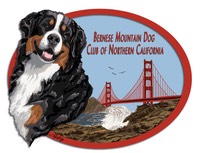The #1 cause of death in all domestic dogs is us: people! About a third of the dogs born in the U.S. never see their second birthday. They are euthanized as unwanted, abandoned or lost dogs in shelters, or die getting hit by a car when running loose. Unfortunately, these fates also befall our beloved Berners. The cheapest form of health insurance is buying a leash, learning how to use it, and training your dog.
The Swiss have a saying about the lifespan of Bernese Mountain Dogs. They say, "Three years a young dog, three years a good dog, three years an old dog ... and three years a gift from God."
In America, at this time, the average age of a Berner at death is about 7 years, though many books say the average life span is 10 to 12 years. The quality of the bond with our dogs increases as they age so that even 12 years is much too brief.
We know the average life span of a Berner because the BMDCA was among the very first AKC clubs to have a national database. Through the efforts of dedicated Bernese people, there exists a computer database of over 10,000 Bernese Mountain Dogs, 900+ kennels, and 2000+ litters, with their attendant health information. Participation in the database is voluntary, and strongly encouraged by the BMDCNC. We hope that all breeders participate and will have researched health data for their bitch, stud, and as many near relatives as possible. They will thus be able to provide you with detailed information, which could prove invaluable as your dog ages. Discuss any data you have with your breeder to verify its accuracy, and let our manager know of any corrections or changes.
The database has been a useful tool for identifying health problems in our breed. We know Bernese do have a higher than average incidence of cancer. Besides the typical canine cancers, Bernese can have histiocytosis -- an heritable cancer which seems to be specific for our breed alone. There is an ongoing cancer study to pinpoint and discern patterns of the cancers which are a particular problem for our breed. The Berner-Garde Foundation has been established to understand and reduce genetic disease in Bernese Mountain Dogs.
Structural problems can afflict our dogs, as they do other breeds. Hip dysplasia is a progressive, degenerative disease involving a malformation of the hip socket joint. It ranges from very mild with no apparent effects, to severe enough to require euthanasia. There is no medical agreement on exact causes but appears to have both genetic and environmental causes. The term 'hips clear' is often used as a bit of a buzz phrase to imply a dog is structurally sound. Hips aren't the only part that can be unsound. Current data suggests that in Bernese, there are more bad elbows and shoulders than there are bad hips.
We continue to debate the relative merits of the various screening organizations and techniques available for evaluating and/or predicting joint problems. No one method is 100% accurate. The oldest organization is the Orthopedic Foundation for Animals (OFA). If a breeder submits X-rays of a dog's hips or elbows to the OFA, radiologists will analyze those X-rays. If they are deemed free of dysplasia, the dog will get a numbered OFA certificate with a rating of Fair, Good, or Excellent. If there is evidence of dysplasia, no number is assigned. An OFA # on a parent does NOT necessarily mean the offspring will have good joints. This is a very complex issue. The PennHIP methodology of screening is relatively new and can be used on very young dogs. It could prove to be a very valuable tool to the potential puppy buyer.
Bernese have a body type which makes them susceptible to bloat, which can be a life threatening emergency medical situation. This can run in families. Our dogs, like other breeds, can have kidney problems, skin problems, autoimmune problems and certain vision problems.
Progressive Retinal Atrophy (PRA) is a hereditary disease of the eye that has been identified in Bernese Mountain Dogs. PRA is a blanket term for many types of retinal diseases, all of which result in blindness. All Bernese Mountain Dogs, regardless of age or breeding status, should be examined yearly by a member of the American College of Veterinary Opthalmologists (A.C.V.O.). Once examined and found free of evidence of heritable eye disease, a number and certificate can be obtained from the Canine Eye Registration Foundation (CERF). This is called a CERF number. The CERF is an organization that collects data on dogs examined by members of the A.C.V.O. and registers those dogs that have been certified free of evidence of heritable eye disease.
The BMDCA has as a resource several veterinarian/members who keep track of the latest information, trends and treatments for various body systems of the Bernese. And of course, club members are always willing to share their scientific and not-so-scientific insights into health matters based on personal experience.
HEALTH REGISTRIES
Berner-Garde:
File manager
Margrit Kitchin
9401 East Jadecrest
Sun Lakes, AZ 85248
(602) 895-2246
Mkitchin@aol.com
Berner-Garde:
Lori Jodar (Chair)
07999 US 31 N., 505
Charlevoix, MI
(616) 547-5705
GDC:
Institute for Genetic Disease Control in Animals
P.O. Box 222
Davis, CA 95617
(916) 756-6773
OFA:
Orthopedic Foundation for Animals
2300 Nifong Blvd.
Columbia, MO 65201
(314) 442-0148
PennHIP:
271 Great Valley Pkwy.
Malvern, PA 19355
(800) 248-8099
CERF:
1248 Lynn Hall
Purdue University
Lafayette, IN 47907
(317) 494-8179
![]() View, download or print resource guide using Adobe Acrobat
View, download or print resource guide using Adobe Acrobat
Information and Resource Guide on this page provided courtesy of the Nashoba Valley Bernese Mountain Dog Club
